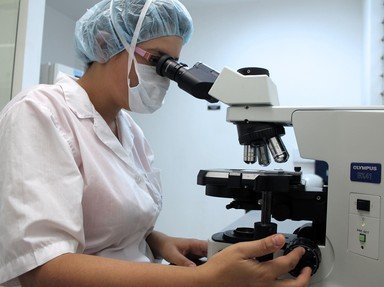Quiz Answer Key and Fun Facts
1. Our cells are different to bacterial cells in that our cells contain membrane-bound compartments known as organelles, allowing proteins to be sorted to different areas. While bacteria are known as prokaryotes, what term is used to describe animals and plants, specifically reflecting the presence of a membrane-bound nucleus?
2. Proteins are synthesised on ribosomes in the cell cytoplasm, and must be targeted to the appropriate compartment of the cell by special targeting sequences. What is likely to be the fate of a protein that contains no such targeting sequence?
3. In order for genes to be properly expressed, many of the proteins involved in their expression need to be transported from the cytoplasm to the nucleus. Proteins targeted to the nucleus possess a "nuclear localisation signal" and are transported through a specialised structure at the nuclear membrane. What is this structure called?
4. As well as nuclear import, nuclear export is important. Which of the following is most likely to be exported from the nucleus?
5. Proteins can be synthesised at the surface of the rough endoplasmic reticulum. Proteins synthesised here usually contain a sequence which allows them to enter the endoplasmic reticulum after synthesis. What makes this endoplasmic reticulum "rough"?
6. The sequence which targets proteins to the endoplasmic reticulum will be cleaved after the protein enters this structure. What will happen to the protein if it contains no further targeting sequences?
7. Proteins which enter the endoplasmic reticulum undergo several modifications which are important to their function. Which of the following modifications is least likely to happen to a protein in the endoplasmic reticulum?
8. Proteins that are not intended to remain in the endoplasmic reticulum move into the Golgi apparatus, where further modification and protein sorting occurs. How do proteins generally move between these different compartments?
9. Some modifications which take place in the Golgi apparatus themselves act as sorting signals for proteins. One such modification is the mannose-6-phosphate tag. To which organelle, which contains several enzymes and which is sometimes referred to as the "suicide bag of the cell", does the mannose-6-phosphate target proteins to?
10. Proteins that are accidentally sorted to the extracellular space are returned to the cell via a process called endocytosis. This requires the binding of these escaped proteins to a type of membrane-bound protein. What name is given to this second set of proteins?
Source: Author
doublemm
This quiz was reviewed by FunTrivia editor
WesleyCrusher before going online.
Any errors found in FunTrivia content are routinely corrected through our feedback system.
